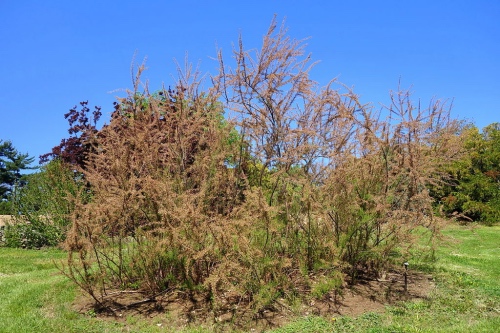
ALVIN JOHNSON takes a look at the Biblical plant known as the ‘eshel’…
In Arabic the Tamarix tree is known as the ‘asal’, so there is linguistic support for identifying the closely related Hebrew word ‘eshel’. So we can be reasonably confident that the eshel is the Tamarix species. Indeed the Tamarix is called an eshel in modern Hebrew.
There are seven varieties of Tamarix in Israel. Three significant species are:
1. The smallflower tamarisk (also called salt cedar tamarix) – Tamarix parviflora
2. The Athel pine – Tamarix aphylla
3. The Nile tamarisk – Tamarix nilotica

The smallflower tamarisk (Tamarix parviflora). PICTURE: Daderot/Public Domain.
Tamarix are a genus of evergreen shrubs or trees. They grow from one to 18 metres in height and often form dense thickets. They usually grow on salty soils, but they can also tolerate alkaline conditions. Generally they are characterised by thin branches and grey-green foliage.
The bark of young plants is smooth and reddish-brown in colour. In older plants, the bark becomes a bluish-purple colour, and is ridged and furrowed.
The leaves secrete salt and it drips water in the morning.
Tamarix have pink to white flowers which appear from March to September, though species like Tamarix aphylla tend to flower during winter.
The athel pine (Tamarix aphylla) is the largest known species of the Tamarix. It is a good shade tree and is used extensively as a windbreak. It can be grown relatively easily, even a branch placed into damp soil can quickly send out roots and establish itself in the soil. Because of this it can be found growing along watercourses in arid areas such as in the Beersheba region of the Negev. The white flowers of the Tamarix aphylla appear in late summer and autumn.
The Nile tamarisk (Tamarix nilotica) can also be found in dry locations, such as the Negev, the Wilderness of Zin and the Wilderness of Paran; as well as in more fertile areas such as in the Galilee region of northern Israel.
There are only a few Biblical references to the eshel in the Old Testament. In these examples it appears to be an important tree:
• “Abraham planted an eshel in Beersheba and called on the Lord there.” – Genesis 21: 33. As noted earlier the tamarisk tree is well suited to the drier conditions that are found around Beersheba. It has a deep root system and can survive on the more brackish water of that area.
• “Now Saul heard that David and his men had been discovered. And Saul was seated, spear in hand, under the eshel (tamarisk) tree on the hill at Gibeah, with all his officials standing at his side.” – I Samuel 22:6. Possibly these two examples above were the Tamarix aphylla because it was a good shade tree.
• After Saul and Jonathon were killed by the Philistines on Mount Gilboa their bodies were taken to Beth Shean and hung on the walls there. Later the men from Jabesh Gilead “took their bones and buried them under an eshel (tamarisk) tree at Jabesh…” – I Samuel 31:13.
• The prophet Isaiah used the eshel as a metaphor for Israel –
“Then I said, ‘For how long, O Lord?’
And he answered:
‘Until the cities lie ruined
and without inhabitant,
until the houses are left deserted
and the fields ruined and ravaged,
until the Lord has sent everyone far away
and the land is utterly forsaken.
And though a tenth remains in the land,
it will again be laid waste.
But as the eshel (terebinth) and allon (oak)
leave stumps when they are cut down,
so the holy seed will be the stump in the land’.”
– Isaiah 6:11–13
This is an edited excerpt from Alvin Johnson’s iBook ‘Biblical Flora’, 2017. The book is available for free download on iTunes. A teacher’s edition is also available for purchase.





